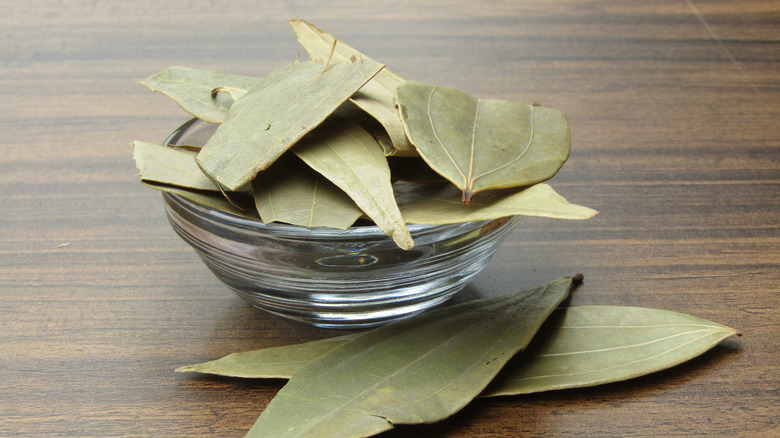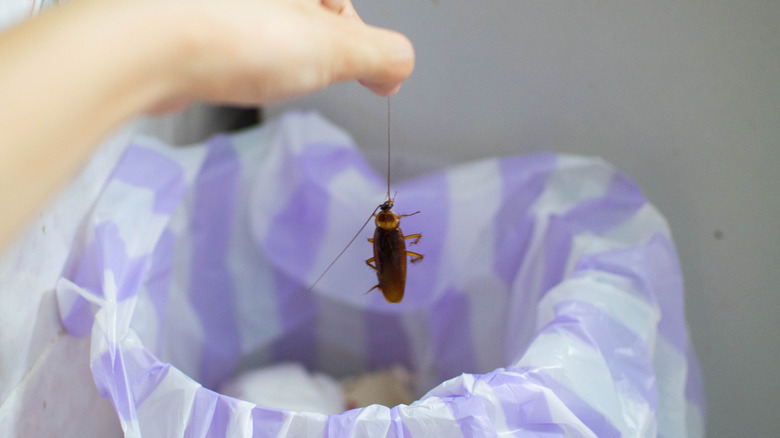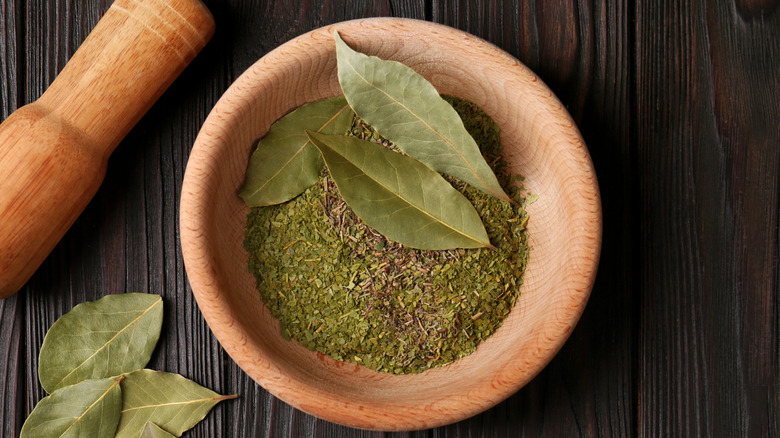Repel Cockroaches Naturally With A Common Kitchen Ingredient
Cockroaches in homes are a widespread issue, affecting households regardless of location. Beyond being seen as a sign of dirtiness, these pests also present health risks. Cockroaches are known carriers of various pathogens and can contaminate food and surfaces they come in contact with, posing potential health risks to inhabitants, such as triggering asthma attacks (via National Center for Healthy Housing). Their rapid reproduction rates and nocturnal habits make them difficult to eradicate once they gain a foothold in your home. Many homeowners resort to chemical pesticides, but these can have their own set of problems. Using chemical treatments can harm both pets and humans, particularly if misused or over-applied. Consequently, there's an increasing inclination towards using everyday household products and ingredients to repel cockroaches; one that works particularly well is Laurus nobilis, better known as bay laurel or bay leaf.
Bay leaves, commonly used in cooking for their aromatic properties, are believed to be an effective natural deterrent against cockroaches because of their chemical composition. While they don't kill these insects, their strong scent can repel them. Placing bay leaves in areas where cockroaches frequent can act as a deterrent. While eco-friendly and typically safe for humans, this method may not entirely eliminate an infestation, especially if you have lots of clutter — a mistake that can draw cockroaches to your home. However, bay leaves can be a part of a broader integrated pest management approach.
How to use bay leaves to keep cockroaches away
Cockroaches are crafty invaders that often infiltrate homes, particularly in areas associated with food. To effectively tap into the deterrent effect of bay leaves, you need a comprehensive strategy. Start by thoroughly inspecting your home, paying close attention to food-related areas like the kitchen, pantry, and dining spaces. These are prime spots where cockroaches love to congregate and feed. Once you've identified these cockroach hotspots, it's time to spread the bay leaves. Place them in bowls or open containers and distribute them throughout the identified zones. This will act as a deterrent for these unwelcome guests. Beyond the obvious areas, ensure you sprinkle bay leaves in storage spaces, such as cupboards, pantries, and drawers. Often overlooked spaces like behind refrigerators, beneath stoves, or inside cabinet crevices can also be breeding grounds for these pests, so pay attention to them as well.
Consider using bay leaves like potpourri if you want a more aesthetic approach. Place them in decorative containers or sachets and display them around your home. This serves the purpose of repelling cockroaches and infuses your home with a refreshing fragrance. By incorporating these measures, you'll be doing more than just scenting your home; you'll create an ambiance that's decidedly unappealing to cockroaches, reducing their desire to invade your living spaces.
How do bay leaves keep cockroaches away?
Bay leaves are a natural deterrent for cockroaches due to certain compounds they contain, including 1,8-Cineole, β-linalool, methyl eugenol, and α-terpinyl acetate. All of these compounds are scientifically proven to repel cockroaches. For example, a study published in Scientific Reports in 2017 (via nature.com) found that 1,8-cineole (also known as eucalyptol), was effective at repelling male German cockroaches. Meanwhile, a 2016 study in the Journal of Anthropod-Borne Diseases (via the National Library of Medicine) concluded that eugenol, linalool, and 1,8-cineole were all toxic to, and repellent against, German cockroach nymphs. Likewise, α-terpinyl acetate is one of the active compounds known to be severely toxic to cockroaches.
Note that the study findings above are based on essential oils, which are highly concentrated plant extracts that contain the insect-repellent compounds in high quantities. The plants themselves have lower concentrations of these elements. However, numerous pest control professionals swear by the repellent prowess of bay leaves alone. The specific scent they emit has a deterrent effect on these pests, even if it's a milder one than the essential oil would offer.
Whether used fresh or dried, bay leaves offer the convenience of not breaking down easily, ensuring that they remain intact and are easy to clean up afterward. Dried bay leaves maintain their distinct aroma for up to a year. Meanwhile, fresh ones emit a stronger, more intense scent.
Tips for warding off cockroaches with bay leaves (and other methods)
Your choice of bay leaves, and how you use them, is an important success factor. Fresh leaves are more effective than dry ones (you should be able to find them at most supermarkets). If you opt for fresh bay laurel, crush the leaves first to release the essential oils that are full of cockroach-repellent compounds. On the other hand, the best way to use dried leaves is to grind them into a powder then sprinkle the latter strategically. This way, you'll ensure a more pungent (and effective) cockroach barrier. You'll need to replace the fresh leaves at least once every few weeks, since they lose their potency quickly. If you're using dry leaves, replace them even more frequently.
If you store grains or flour in bags, the best strategy is to place the crushed leaves directly into the bags. This will discourage the pests from going inside. You can discard remnants of the leaves when you use the bags' contents to cook, but it's not a big deal if traces of the leaves end up in your food.
Bay leaves aren't the only kitchen ingredient that will help in your fight against cockroach infestations. Catnip is an herb in the mint family, and its constituent nepetalactone is a strong insect deterrent. Stuff sachets with fresh catnip and place them in cockroach-infested areas. You can also banish the pests with this two-ingredient spray containing oregano oil and water. Alternatively, try using lemon peels to prevent a cockroach infestation altogether. Apart from trying natural repellents, it's vital to maintain a clean household. Regularly clear away food crumbs and other residues that might attract cockroaches; this way, your home won't seem as appealing to the pests in the first place.



